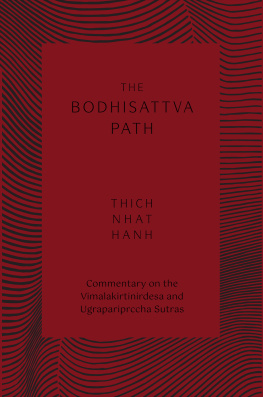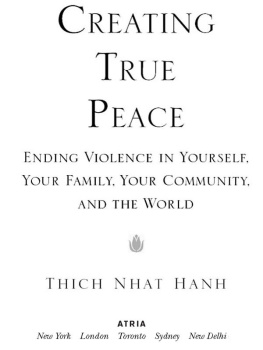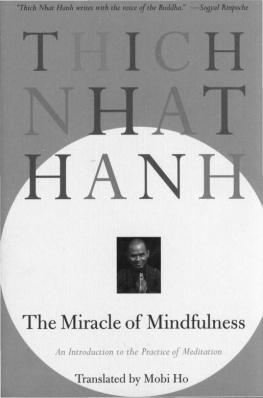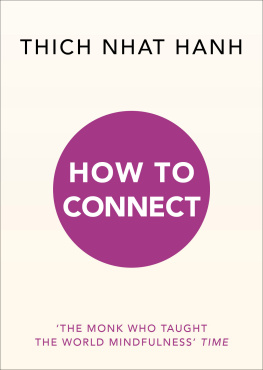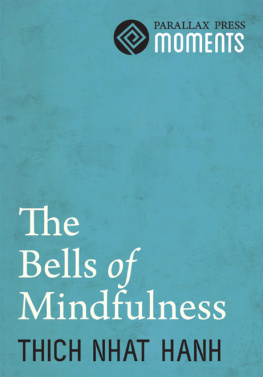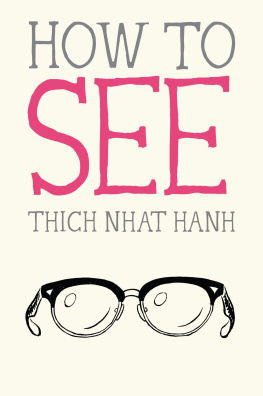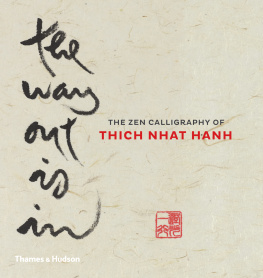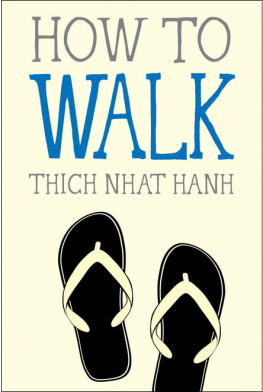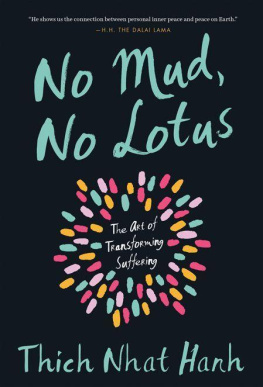Table of Contents
A portion of the proceeds of every book sold goes to support nonprofit projects in Vietnam.
INTRODUCTION
MINDFULNESS is our ability to be aware of what is going on both inside us and around us. It is the continuous awareness of our bodies, emotions, and thoughts. Through mindfulness, we avoid harming ourselves and others, and we can work wonders. If we live mindfully in everyday life, walk mindfully, are full of love and caring, then we create a miracle and transform the world into a wonderful place.
The object of your mindfulness can be anything. You can look at the sky and breathe in and say, Breathing in, Im aware of the blue sky. So you are mindful of the blue sky. The blue sky becomes the object of your mindfulness. Breathing out, I smile to the blue sky. Smiling is another kind of practice. First of all, you recognize the blue sky as existing. And if you continue the practice, you will see that the blue sky is wonderful. It may be that youve lived thirty or forty years but you have never seen and touched the blue sky that deeply.
In the Sutra on the Four Establishments of Mindfulness, the Buddha offers four layers of mindfulness practice: mindfulness of the body, of the emotions, of the mind, and of the objects of mind. Practicing mindfulness at each layer can be the foundation of well-being and happiness. When we dont practice mindfulness, we suffer in our body, our mind, and our relationships. In practicing mindfulness, we become a peaceful refuge for ourselves and others. When the seed of mindfulness in us is watered, it can grow into enlightenment, understanding, compassion, and transformation. The more we practice mindfulness, the stronger this seed will grow.
Clarity flows from mindfulness. When we are mindful, we can practice Right Thinking and Right Speech. With the energy of mindfulness, we can always return to our true home, the present moment.
The Chinese character for mindfulness reveals its meaning. The upper part of the character means now and the lower part stands for mind or heart. The Vietnamese word for mindfulness, chan niem, means to be truly in the present moment. Mindfulness helps us to come back to the here and now, to be aware of what is going on in the present moment, and to be in touch with the wonders of life.
THE SEVEN MIRACLES OF MINDFULNESS
If we bring mindfulness into every aspect of our life, we cannot help but experience lifes miracles.
THE FIRST MIRACLE is to be present and able to touch deeply the miracles of life, like the blue sky, a flower, the smile of a child.
THE SECOND MIRACLE is to make the otherthe sky, a flower, a childpresent also. Then we have the opportunity to see each other deeply.
THE THIRD MIRACLE is to nourish the object of your attention with full awareness and appropriate attention.
THE FOURTH MIRACLE is to relieve the suffering of others.
THE FIFTH MIRACLE is looking deeply into the nature of self and others.
THE SIXTH MIRACLE is understanding. If we are mindful of the present moment, we can see deeply and things become clear. With understanding, the desire to relieve suffering and give love will awaken within us.
THE SEVENTH MIRACLE is transformation. By practicing Right Mindfulness, we touch the healing and refreshing aspects of life and begin to transform the suffering in ourselves and in the world.
Our true home is the present moment. If we really live in the moment, our worries and hardships will disappear and we will discover life with all its miracles. Real life can only be found and touched in the here and now. This is because the present moment is the only moment we can actually experience and influence. The past is over and the future has not yet arrived. Since the present moment is the only real moment for us, we can always return there to get in touch with the wonders of life.
As long as we are consumed with our everyday problemsdistress about the present, regrets about the past, or constant worries about the futurewe cannot be free people; we are not able to live in the here and now.
BREATHING AND MOVING MINDFULLY
No one can be successful in the art of meditation without having passed through the gate of breathing. The practice of mindfulness encompasses all spheres and activities, including ordinary actions and our every breath.
We often assume breathing is just a natural skill; everyone knows how to inhale and exhale. But breathing is a miracle. Being aware of our breath not only helps us manage the difficulties in everyday life, it also helps develop our wisdom and compassion. We can sit and breathe, but it is just as important to practice mindful breathing while we are moving.
Life is a path, but life is not about getting to a certain place. The Mindful Movements and walking meditation are ways to practice moving without a goal or intention. Mindful walking simply means walking while being aware of each step and of our breath. It can be practiced anywhere, whether you are alone in nature or with others in a crowded city. You can even practice mindful breathing and walking meditation in between business appointments or in the parking lot of the supermarket. Walking on this planet is a joy. Mindful walking allows us to be aware of the pleasure of walking. We can keep our steps slow, relaxed, and calm. There is no rush, no place to get to, no hurry. Mindful walking can release our sorrows and our worries and help bring peace into our body and mind.
We can practice walking meditation alone, with another person, or with a group. Placing our footsteps one after the other slowly and in silence, we can create joy with each step. If we take steps without anxiety, in peace and joy, then we cause a flower to bloom on the earth with every step.
THE TEN MINDFUL MOVEMENTS are another wonderful way of connecting your mind and body in mindfulness. They are a way to touch the sky, to smile at your own body, and to touch your heart. When you do them, please enjoy each part of each movement. Do only what you can. They are not like aerobics, where you have to move quickly and keep up. There is no need to rush. When I do them, I find I cannot help smiling. I hope they bring you joy.
Thich Nhat Hanh
THE TEN MINDFUL MOVEMENTS
This is Thich Nhat Hanh. His friends call him Thay.
Hes a Vietnamese Buddhist monk.
Thich Nhat Hanh grew up in Vietnam at a time when there was a lot of conflict and violence.
He was exiled because of his outspoken peace activities during the Vietnam War. Thich Nhat Hanh saw that it was very important for each person to practice finding peace within themselves. So in 1982, he founded Plum Village, a community of monks, nuns, laymen, and laywomen in southwest France.
When people have peace in themselves, then there can be peace in the world.
This is our practice every day.







